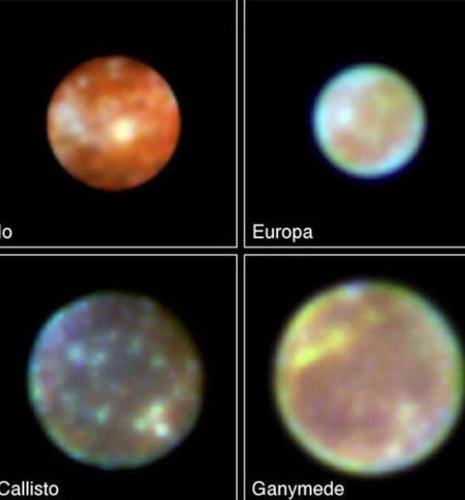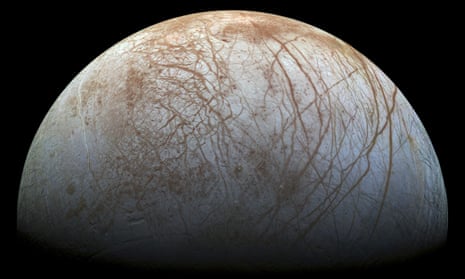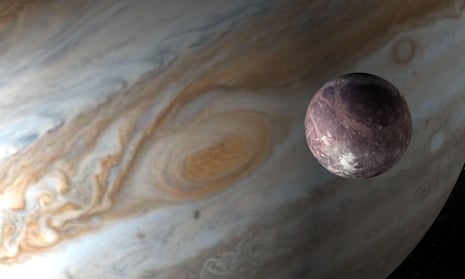Europa has a smooth, icy surface while Ganymede is the largest moon in the solar system. Both moons are part of Jupiter’s system and are intriguing targets for scientific exploration.
Europa is known for its potential subsurface ocean that may harbor life, while Ganymede boasts a unique magnetic field and traces of past geological activity. Understanding the differences between Europa and Ganymede offers valuable insights into the diversity of the moons in our solar system and the potential for discovering extraterrestrial life.
Scientists continue to study these fascinating moons to unlock their secrets and advance our understanding of the universe.
Formation And Composition
Europa and Ganymede, two of Jupiter’s moons, formed billions of years ago.
Ganymede, the largest moon in the solar system, is composed of rock and ice.
Europa’s surface is covered by a layer of water ice and displays unique geological features.
Europa’s surface is characterized by chaotic terrain, ridges, and fractures due to the shifting ice crust.
Ganymede boasts a varied landscape with craters, grooves, and plains resulting from geological processes.
| Moon | Geological Features |
|---|---|
| Europa |
|
| Ganymede |
|

Credit: en.wikipedia.org
Surface Conditions
Explore surface conditions on Europa and Ganymede. Europa’s icy shell conceals a subsurface ocean, while Ganymede displays a mix of older and newer terrains. Each moon offers unique insights into the possibility of extraterrestrial life.
Surface Conditions: Europa and Ganymede, two of Jupiter’s largest moons, boast intriguing surface conditions.Presence Of Water
– Europa has a frozen crust covering a global subsurface ocean. – Ganymede also contains subsurface oceans beneath its icy exterior.Potential For Life
– The presence of liquid water on Europa and Ganymede hints at potential for life. – Research suggests microbial life might exist in these subsurface oceans. Explore the unique surface conditions of Europa and Ganymede, revealing possibilities for life beyond Earth.Exploration And Missions
Europan and Ganymedean moons of Jupiter have long been objects of fascination and research for space exploration enthusiasts. The potential for discovering extraterrestrial life and understanding the geology of these celestial bodies has led to several missions by NASA. Let’s delve into the exploration and missions dedicated to uncovering the secrets of Europa and Ganymede.
Nasa’s Missions To Europa
Europa, with its subsurface ocean, has intrigued scientists aiming to search for potential life beyond Earth. NASA has been at the forefront of exploring Europa, with its upcoming Europa Clipper mission. This mission aims to investigate the moon’s ocean, ice shell, and geology, providing valuable insights into its habitability. The spacecraft is set to conduct flybys, mapping and studying Europa’s surface to understand its potential as a habitat for life.
Nasa’s Missions To Ganymede
Ganymede, the largest moon in the solar system, has also attracted NASA’s interest. The upcoming Europa Clipper mission is designed to include several flybys of Ganymede as well. Additionally, the JUICE (JUpiter ICy moons Explorer) mission by the European Space Agency (ESA) in collaboration with NASA targets a detailed exploration of Ganymede, along with Jupiter and other Jovian moons. This mission aims to understand the moon’s ice crust, subsurface ocean, and magnetic field interaction with Jupiter, providing crucial data for future exploration and understanding of extraterrestrial environments.

Credit: qctimes.com
Magnetic Field And Auroras
Europa and Ganymede, the two largest moons of Jupiter, both possess intriguing magnetic fields.
Europa’s magnetic field is created by a subsurface layer of the moon’s conductive saltwater ocean.
Ganymede, on the other hand, generates its magnetic field using a combination of a metallic iron core and subsurface saltwater ocean.
Adorning the polar regions of both Europa and Ganymede, auroras create a stunning natural light show.
Auroras occur when charged particles from the sun, such as electrons and protons, interact with the moons’ magnetic fields.
These particles are guided along the magnetic field lines to the poles, where they collide with atoms and molecules in the thin atmosphere, creating luminous displays.
Understanding The Magnetic Field
- Europa’s magnetic field is generated by a subsurface conductive saltwater ocean.
- Ganymede’s magnetic field is produced by a metallic iron core and a saltwater ocean beneath its surface.
- Both moons boast intriguing magnetic fields, suggesting the presence of subsurface oceans.
Phenomenon Of Auroras
- Auroras embellish the polar regions of Europa and Ganymede, put on a mesmerizing natural light show.
- Charged particles from the sun interact with the moons’ magnetic fields to create the auroras.
- These particles are guided along the magnetic field lines to the poles where they collide with atoms and molecules in the thin atmosphere of the moons.
- These collisions result in the vibrant and colorful displays observed on Europa and Ganymede.
Size And Distance From Jupiter
Jupiter, the largest planet in our solar system, is surrounded by numerous moons, two of which are Europa and Ganymede. In this section, we will examine the comparative analysis and relationship of these moons with Jupiter based on their size and distance.
Comparative Analysis
Europa and Ganymede, the fourth and largest moons of Jupiter respectively, differ significantly in size and distance from their parent planet.
| Moon | Diameter | Distance from Jupiter |
|---|---|---|
| Europa | 3,121.6 kilometers | 670,900 kilometers |
| Ganymede | 5,268.2 kilometers | 1,070,400 kilometers |
As indicated by the table above, Ganymede is significantly larger than Europa, with a diameter of 5,268.2 kilometers compared to Europa’s 3,121.6 kilometers. The difference in size between these two moons highlights the spectacular diversity within Jupiter’s system.
Regarding distance from Jupiter, Ganymede is situated at a greater distance of 1,070,400 kilometers compared to Europa’s distance of 670,900 kilometers. This variance in distance also contributes to the distinctive characteristics and features of each moon.
Relationship With Jupiter
Both Europa and Ganymede have a unique relationship with Jupiter, being moons that orbit around this gas giant. Their orbits are influenced by Jupiter’s immense gravitational pull and contribute to the dynamics of the entire Jovian system.
Europa is classified as a Galilean moon, along with three other moons (Io, Ganymede, and Callisto), as they were discovered by Galileo Galilei in 1610. Europa’s position near Jupiter allows it to experience tidal forces, causing significant geological activity and leading to the presence of a subsurface ocean beneath its icy crust.
Ganymede, on the other hand, holds the distinction of being the largest moon in the solar system. With a size exceeding that of the planet Mercury, Ganymede has its magnetic field and water-ice crust. The interaction between its magnetic field and Jupiter’s magnetosphere creates a fascinating dynamic within the Jovian system.
In conclusion, Europa and Ganymede, while sharing a relationship with Jupiter, differ in terms of size and distance. This diversity emphasizes the complex nature of Jupiter’s moon system, providing scientists and astronomers with valuable insights into the formation and evolution of moons around gas giants.

Credit: www.theguardian.com
Future Prospects
The future prospects of Europa and Ganymede are filled with exciting opportunities for research and space exploration. As scientists continue to make groundbreaking discoveries about these two moons of Jupiter, the potential for uncovering new knowledge about the possibility of life beyond Earth and the feasibility of future space missions is unparalleled.
Research And Discoveries
Recent missions and studies have revealed intriguing insights into the subsurface oceans of Europa and Ganymede. Evidence of potential habitable environments beneath their frozen surfaces has sparked a keen interest among researchers. The ongoing exploration of these moons promises to yield further revelations about the conditions necessary for supporting life.
Implications For Space Exploration
The unique characteristics of Europa and Ganymede have significant implications for future space exploration. Their subsurface oceans offer potential targets for missions seeking to investigate the presence of extraterrestrial life. Furthermore, the prospect of utilizing these moons as bases for sustainable space habitats is an exciting area for future research and development.
Frequently Asked Questions On Europa Vs Ganymede
How Are Europa And Ganymede Different From Each Other?
Europa and Ganymede are two of Jupiter’s moons, but they have distinct features. Europa has a smooth icy surface with evidence of a subsurface ocean, while Ganymede is the largest moon in the solar system with a rocky surface and its own magnetic field.
Which Moon, Europa Or Ganymede, Has Better Chances Of Supporting Life?
Europa has higher potential for supporting life due to its subsurface ocean, which may provide the necessary conditions for microbial life. Ganymede, on the other hand, has a hostile surface with no signs of liquid water.
How Do Europa And Ganymede Contribute To Our Understanding Of The Outer Solar System?
Europa and Ganymede are both crucial for studying the outer solar system. Europa’s subsurface ocean offers insights into the possibilities of extraterrestrial life, while Ganymede’s magnetic field helps us understand the interactions between moons and their surrounding environments.
Do Europa And Ganymede Have Any Similarities?
Europa and Ganymede share some similarities as Jupiter’s moons, such as being composed mostly of ice and having gravitational interactions with each other. However, their individual characteristics and features set them apart from each other.
Conclusion
Both Europa and Ganymede have unique features that make them intriguing destinations for exploration. Their potential to host life and their distinct geology present exciting opportunities for further investigation. Whether it’s the icy crust of Europa or the diverse surface of Ganymede, Jupiter’s moons continue to captivate scientists and space enthusiasts alike.



